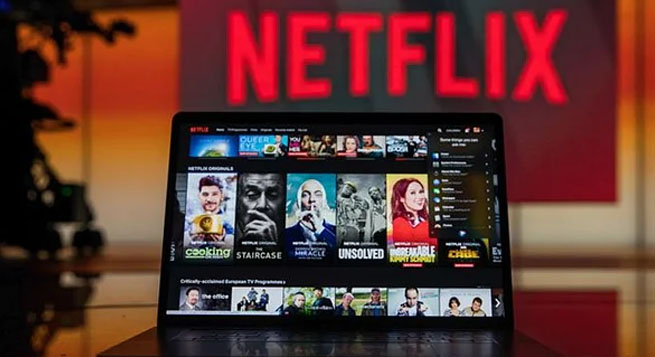Fazed by subscriber loss of 200,000 and gloomy predictions for the future in short term, Netflix is looking at an ad-supported option for consumers as also a crackdown on rampant password sharing around the globe, which is potential revenue loss for the company.
Netflix suffered its first subscriber loss in more than a decade, causing its shares to plunge 25 percent in extended trading Tuesday in the US, amid concerns that the pioneering streaming service may have already seen its best days.
The company’s customer base fell by 2,00,000 subscribers during the January-March 2022 period, according to its quarterly earnings report released Tuesday, AP and Reuters reported.
It’s the first time that Netflix’s subscribers have fallen since the streaming service became available throughout most of the world outside of China six years ago. The drop this year stemmed in part from Netflix’s decision to withdraw from Russia to protest the war against Ukraine, resulting in a loss of 7,00,000 subscribers.
Even so, Netflix acknowledged its problems are deeply rooted by projecting a loss of another two million subscribers during the April-June period.
Netflix also lost 8,00,000 subscribers in 2011 after it unveiled plans to begin charging separately for its then-nascent streaming service, which had been bundled for free with its traditional DVD-by-mail service. The customer backlash to that move elicited an apology from Netflix CEO Reed Hastings for botching the execution of the spin-off.
The service also saw a decline in US subscribers in 2019.
But the latest subscriber loss was far worse than a forecast by Netflix management for a conservative gain of 2.5 million subscribers. The news deepens troubles that have been mounting for the streaming since a surge of signups from a captive audience during the pandemic began to slow.
It marks the fourth time in the last five quarters that Netflix’s subscriber growth has fallen below the gains of the previous year. Now investors fear that its streaming service may be mired in a malaise that has been magnified by stiffening competition from well-funded rivals such as Apple and Walt Disney.
The setback follows the company’s addition of 18.2 million subscribers in 2021, its weakest annual growth since 2016. That contrasted with an increase of 36 million subscribers during 2020 when people were corralled at home and starved for entertainment, which Netflix was able to quickly and easily provide with its stockpile of original programming.
Netflix has previously predicted that it will regain its momentum but is now starting to acknowledge that it needs to take action. Among other things, Netflix signalled that it will likely crackdown on the sharing of subscriber passwords that have enabled multiple households to access its service from a single account.
The Los Gatos, California, company estimated that about 100 million households worldwide are watching its service for free by using the account of a friend or another family member, including 30 million in the US and Canada. To stop the practice and prod more people to pay for their accounts, Netflix indicated it may expand a test introduced last month in Chile, Peru, and Costa Rica that allows subscribers to add up to two people living outside their households to their accounts for an additional fee.
“Account sharing as a percentage of our paying membership hasn’t changed much over the years, but, coupled with the first factor, means it’s harder to grow membership in many markets — an issue that was obscured by our COVID growth,” Netflix said Tuesday in a letter to its shareholders.
Netflix ended March with 221.6 million worldwide subscribers.
With the pandemic easing, people have been finding other things to do, and other video streaming services are working hard to lure new viewers with their award-winning programming. Apple, for instance, held the exclusive streaming rights to ‘CODA’, which eclipsed Netflix’s ‘Power of The Dog’, among other movies, to win Best Picture at last month’s Academy Awards.
Escalating inflation over the past year has also squeezed household budgets, leading more consumers to rein in their spending on discretionary items.
Despite that pressure, Netflix recently raised its prices in the US, where it has its greatest household penetration— and where it’s had the most trouble finding more subscribers— while slashing prices in India. In the most recent quarter, Netflix lost 640,000 subscribers in the US and Canada, prompting management to point out that most of its future growth will come in international markets.
Netflix also is trying to give people another reason to subscribe by adding video games at no extra charge — a feature that began to roll out last year.
“Those who have followed Netflix know that I’ve been against the complexity of advertising, and a big fan of the simplicity of subscription,” Reuters quoted Netflix CEO Reed Hastings as saying, “But, as much as I’m a fan of that, I’m a bigger fan of consumer choice.”
Hastings told investors that the pandemic had “created a lot of noise”, making it difficult for the company to interpret the surge and ebb of its subscription business over the last two years. Now, it appears the culprit is a combination of competition and the number of accounts sharing passwords, making it harder to grow.
“When we were growing fast, it wasn’t a high priority to work on,” Hastings said of account-sharing in remarks during Netflix’s investor video, “And now we’re working super hard on it.”
 SRK, Aamir, Big B, Ted Sarandos, WPP CEO, MPA chief, other stars, to headline WAVES
SRK, Aamir, Big B, Ted Sarandos, WPP CEO, MPA chief, other stars, to headline WAVES  TIPS Music ends FY25 on high note with 29% revenue growth
TIPS Music ends FY25 on high note with 29% revenue growth  WAVES’ Bharat Pavillion to showcase Indian media’s evolution,culture
WAVES’ Bharat Pavillion to showcase Indian media’s evolution,culture  Sony AATH to launch ‘Jiyo Gopuda’ on April 26
Sony AATH to launch ‘Jiyo Gopuda’ on April 26  Rajkummar Rao’s ‘Maalik’ gets new theatrical release date
Rajkummar Rao’s ‘Maalik’ gets new theatrical release date  Kriti Sanon joins Dreame as brand’s first-ever ambassador in India
Kriti Sanon joins Dreame as brand’s first-ever ambassador in India  YO YO Honey Singh, Stage Aaj Tak wrap up ‘Millionaire Tour’
YO YO Honey Singh, Stage Aaj Tak wrap up ‘Millionaire Tour’  Prime Video announces global premiere for ‘Crazxy’
Prime Video announces global premiere for ‘Crazxy’ 








